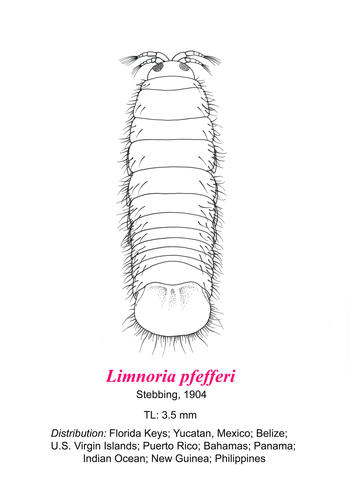Invasion History
First Non-native Panama (Caribbean) Tidal Record: 1976Panama Invasion History:
Invasion history elsewhere in the world:
Limnoria pfefferi has been collected in pine and hardwood test blocks, dock pilings, and in the roots of Red Mangroves (Rhizophora mangle) in the Bahamas, Belize, Quintana Roo (Mexico), Cuba, Puerto Rico, Panama and Colombia (Kensley and Schotte 1987; Markham et al. 1990; U.S. National Museum of Natural History 2016).
Description
Limnoria pfefferi has a small, nearly cylindrical body. The cephalon (head region) is compressed and ovoid, with lateral eyes. The cephalon is distinct from the pereion (thoracic region) and freely rotates. Antennas 1 and 2 are equally anterior, with an obvious scale on Antenna 1. The flagellum of second antenna has four segments. The left mandible incisor lacks teeth, instead forming a projecting rasp-and-file device. The epipodite of the maxilliped just reaches the articulation of the first article of the palp, and is widest near the distal end, about two and one-half times as long as wide. The fifth somite of the pleon is marked dorsally with a median longitudinal Y-shaped keel. Its uropods are greatly reduced, with the exopod much shorter than the endopod, and bearing a small apical claw. The dorsal surface of the pleotelson lacks large tubercles anteriorly, but the posterior edge is lined with fine tubercles and bristles. Adults are up to 4.7 mm long, and yellow when preserved in alcohol. Description based on information from: Menzies 1957; and Cookson 1990.
Taxonomy
Taxonomic Tree
| Kingdom: | Animalia | |
| Phylum: | Arthropoda | |
| Subphylum: | Crustacea | |
| Class: | Malacostraca | |
| Subclass: | Eumalacostraca | |
| Superorder: | Peracarida | |
| Order: | Isopoda | |
| Suborder: | Flabellifera | |
| Family: | Limnoriidae | |
| Genus: | Limnoria | |
| Species: | pfefferi |
Synonyms
Potentially Misidentified Species
Indian Ocean, New Guinea, Belize (Cookson 1990).
Limnoria quadripunctata
Known mostly from temperate waters (Menzies 1957)
Limnoria sexcarinata
Known mostly from Thailand and Japan (Cookson 1990).
Limnoria tripunctata
Widespread in warm-temperate to tropical waters (Menzies 1957)
Ecology
General:
Limnoria pfefferi has separate sexes, and copulation is internal. Typically, in Limnoria spp., a single pair occupies a boring tunnel, with the female closer to the opening. The young are brooded by the female (Becker 1971). Adults and juveniles swarm seasonally, and colonize new pieces of wood. They prefer rough surfaces of relatively soft wood, preferably infected by fungi (Becker 1971). Limnoria pfefferi has been collected in pine and hardwood test blocks, rotting logs, and mangrove roots (Menzies 1957; Kensley and Schotte 1987; Cookson 1990; Markham et al. 1990; Cookson et al. 2013).
Food:
Wood
Trophic Status:
Herbivore
HerbHabitats
| General Habitat | Coarse Woody Debris | None |
| General Habitat | Marinas & Docks | None |
| General Habitat | Mangroves | None |
| General Habitat | Vessel Hull | None |
| Salinity Range | Polyhaline | 18-30 PSU |
| Salinity Range | Euhaline | 30-40 PSU |
| Tidal Range | Subtidal | None |
| Tidal Range | Low Intertidal | None |
| Vertical Habitat | Epibenthic | None |
Tolerances and Life History Parameters
| Maximum Length (mm) | 3.5 | Menzies 1957 |
| Broad Temperature Range | None | Subtropical-Tropical |
| Broad Salinity Range | None | Polyhaline-Euhaline |
General Impacts
Limnoria pfefferi is one of a group of tropical limnoriids (gribbles) which are important borers in mangrove forests and tropical harbors (Pillai 1967; Nair 1984; Cookson et al. 2015). Specific impacts of L. pfefferi have not been documented.Regional Distribution Map
Non-native
Native
Cryptogenic
Failed
Occurrence Map
References
Becker, Gunther (1971) On the biology, physiology, and ecology of marine wood-boring crustaceans., In: Gareth Jones, E. B.//Eltringham, S. K.(Eds.) Marine borers, fungi, and fouling organisms of wood.. , Brussels. Pp. 303-326Carlton, James T.; Ruckelshaus, Mary H. (1997) Nonindigenous marine invertebrates and algae of Florida, In: Simberloff, Daniel, Schmitz, Don C., Brown, Tom C.(Eds.) Strangers in Paradise: Impact and Management of Nonindigenous Species in Florida. , Washington, D.C.. Pp. 187-201
Cookson, L. J.; Cragg, S. M.; Hendy, L. W. (2013) Wood-boring limnoriids (Crustacea, Isopoda) including a new species from mangrove forests of the Tukang Besi Archipelago, Indonesia, Zootaxa 3248: 25-34
Cookson, Laura J. (1990) Australasian Species of Limnoriidae (Crustacea: Isopoda), Memoirs of the Museum of Victoria 52(2): 137-262
Kensley, Brian, Schotte, Marilyn (1987) New records of isopod crustacea from the Caribbean, the Florida Keys, and the Bahamas, Proceedings of the Biological Society of Washington 100(1): 216-247
Markham, John C.; Donath-Hernandez, Francisco; Villalobos-Hiriart, Jose L.; Diaz-Barriga, Antonio-Cantu (1990) Notes on the shallow-water marine Crustacea of the Caribbean coast of Quintana Roo, Mexico, Anales del Instituto de Biologia, Universidad Nacional Autonoma de Mexico, Serie Zoologia 61(3): 405-446
Menzies, Robert J.; Glynn, Peter W. (1968) The common marine custaceans of Puerto Rico, Studies of the Fauna of Curacao and other Caribbean Islands 27: 1-33
Menzies, Robert James (1957) The marine borer family Limnoriidae (Crustacea, Isopoda). Part I: Northern and Central America: Systematics, distribution, and ecology, Bulletin of Marine Science of the Gulf and Caribbean 7(2): 101-200
Nair, N. Balakrishnan (1984) The problem of marine timber destroying organisms along the Indian coast, Proceedings of the Indian Academy of Sciences 93(3): 203-223
Pillai, N. Krishna (1967) Proceedings of the symposium on Crustacea, Pt. V Marine Biological Association of India, <missing place>. Pp. 1274-1283
U.S. National Museum of Natural History 2002-2021 Invertebrate Zoology Collections Database. http://collections.nmnh.si.edu/search/iz/
